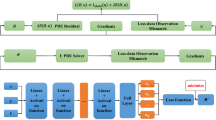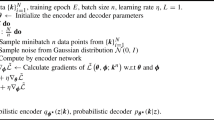Abstract
Almost sophisticated physical phenomena and computational problems arise as variational problems. Recently, the development of neural networks (NNs), which has accomplished unbelievable success in many fields, especially in scientific computational fields. And almost sophisticated computational problems of physical phenomena can be viewed as a variational or PDE problem. In this work, we proposed learning Laplace-Beltrami-operator with physics-constrained machine learning and automatic differentiation to discover the inverse variational problems from noisy data. Also, the hidden fields are approximated by neural networks. Meanwhile, the neural networks and traditional high-order inverse variational problems are integrated, to make the traditional variational problem gain stronger vitality once again. We propose a way for sensitivity analysis, utilizing the automatic differentiation mechanism embedded in the framework. We propose a neural network approach to approximate unknown functions based on curvature regularity to learn the high order inverse variational problems under noisy data. Also, theoretically, our framework is flexible to adapt to the different high-order curvature-based variational problems, then, the NNs are used to solve the problems to improve computational efficiency. Furthermore, several experiments with different initial data and different noise levels are implemented to demonstrate the effectiveness and superiority of the proposed models. Our experiments confirm this property.






Similar content being viewed by others
References
Li C, Yang Y, Liang H, Wu B (2021) Transfer learning for establishment of recognition of COVID-19 on CT imaging using small-sized training datasets. Knowl Based Syst 218:106849–106849
Kobler E, Effland A, Kunisch K, Pock T (2020) Total Deep Variation for Linear Inverse Problems. In: Proceedings of the IEEE/CVF Conference on computer vision and pattern recognition, pp 7549–7558
Gu Z, Li F, Fang F, Zhang G (2019) A novel Retinex-based fractional-order variational model for images with severely low light. IEEE Trans Image Process 29:3239–3253
Capuani R, Dutta P, Nguyen KT (2021) Metric entropy for functions of bounded total generalized variation. SIAM J Math Anal 53(1):1168–1190
Mu J, Xiong R, Fan X, Liu D, Wu F, Gao W (2020) Graph-based non-convex low-rank regularization for image compression artifact reduction. IEEE Trans Image Process 29:5374–5385
Gao Y, Bredies K (2018) Infimal convolution of oscillation total generalized variation for the recovery of images with structured texture. SIAM J Imaging Sci 11(3):2021–2063
Ma J, He J, Yang X (2020) Learning geodesic active contours for embedding object global information in segmentation CNNs. IEEE Trans Med Imaging 40(1):93–104
Liang L, Jin L, Xu Y (2020) PDE learning of filtering and propagation for Task-Aware facial intrinsic image analysis, IEEE Transactions on Cybernetics
Chen X, Williams BM, Vallabhaneni S, Czanner G, Williams R, Zheng Y (2019) Learning active contour models for medical image segmentation. In: 2019 IEEE/CVF Conference on computer vision and pattern recognition (CVPR), pp 11624–11632
Wu F, Zhuang X (2021) Unsupervised domain adaptation with variational approximation for cardiac segmentation, IEEE Transactions on Medical Imaging, vol PP
Wang X, Chen H, Xiang H, Lin H, Heng P (2021) Deep virtual adversarial self-training with consistency regularization for semi-supervised medical image classification. Med Image Anal 70:102010
Li C, Yang Y, Liang H, Wu B (2021) Robust PCL discovery of data-driven mean-field game systems and control problems, IEEE Transactions on Circuits and Systems I: Regular Papers
Wang K-J, Wang G-D (2021) Solitary and periodic wave solutions of the generalized Fourth-Order boussinesq equation via he’s variational methods. Math Methods Appl Sci 44(7):5617– 5625
Kharazmi E, Zhang Z, Karniadakis G (2021) hp-VPINNs: Variational physics-informed neural networks with domain decomposition. Comput Methods Appl Mech Eng 374:113547
Dupuy M-S (2021) Variational projector-augmented wave method: A full-potential approach for electronic structure calculations in solid-state physics. J Comput Phys 442:110510
Boṫ RI, Csetnek ER, László SC (2021) Tikhonov Regularization of a Second Order Dynamical System with Hessian Driven Damping. Math Program 189(1):151–186
Dong B, Ju H, Lu Y, Shi Z (2020) CURE: Curvature regularization for missing data recovery. SIAM J Imaging Sci 13(4):2169–2188
He Y, Kang SH, Liu H (2020) Curvature Regularized Surface Reconstruction from Point Clouds. SIAM J Imaging Sci 13(4):1834–1859
Gundogdu E, Constantin V, Parashar S, Seifoddini A, Dang M, Salzmann M, Fua P (2020) GarNet++: Improving Fast and Accurate Static 3D Cloth Draping by Curvature Loss, IEEE Transactions on Pattern Analysis and Machine Intelligence, vol PP
Spencer J, Chen K, Duan J (2018) Parameter-Free Selective segmentation with convex variational methods. IEEE Trans Image Process 28(5):2163–2172
Jaouen V, Bert J, Boussion N, Fayad H, Hatt M, Visvikis D (2018) Image enhancement with PDEs and nonconservative advection flow fields. IEEE Trans Image Process 28(6):3075–3088
Corsaro S, De Simone V, Marino Z (2021) Split Bregman iteration for multi-period mean variance portfolio optimization, vol 392
Liu R, Mu P, Zhang J (2021) Investigating customization strategies and convergence behaviors of task-specific ADMM. IEEE Trans Image Process 30:8278–8292
Khan S, Huh J, Ye JC (2021) Variational formulation of unsupervised deep learning for ultrasound image artifact removal. IEEE Trans Ultrason Ferroelectr Freq Control 68(6):2086– 2100
Wu Z-C, Huang T-Z, Deng L-J, Hu J-F, Vivone G (2021) VO+ Net: an adaptive approach using variational optimization and deep learning for panchromatic sharpening, IEEE Transactions on Geoscience and Remote Sensing
Weinan E, Yu B (2018) The deep Ritz method: A deep learning-based numerical algorithm for solving variational problems. Commun Math Stat 6(1):1–12
Thanh DNH, Prasath VS, Dvoenko S et al (2021) An adaptive image inpainting Method based on Euler’s elastica with adaptive parameters estimation and the discrete gradient method. Signal Process 178:107797
Fazel M, Hindi H, Boyd SP (2003) Log-det heuristic for matrix rank minimization with applications to hankel and euclidean distance matrices. In: Proceedings of the 2003 american control conference, 2003., vol 3, pp 2156–2162 IEEE
Chambolle A, Pock T (2019) Total Roto-Translational variation. Numer Math 142(3):611–666
Laurain A, Walker SW (2021) Optimal control of volume-preserving mean curvature Flow. J Comput Phys 438:110373
Zhu W (2020) Image denoising using lp-norm of mean curvature of image surface. J Sci Comput 83(2):1–26
Zaitzeff A, Esedoḡlu S, Garikipati K (2020) Second order threshold dynamics schemes for two phase motion by mean curvature. J Comput Phys 410,:109404
Li B (2021) Convergence of dziuk’s semidiscrete finite element method for mean curvature flow of closed surfaces with high-order finite elements. SIAM J Numer Anal 59(3):1592–1617
Smets BM, Portegies J, St-Onge E, Duits R (2021) Total Variation and Mean Curvature PDEs on the Homogeneous Space of Positions and Orientations. J Math Imaging Vis 63(2):237–262
Nie R, Ma C, Cao J, Ding H, Zhou D (2021) A Total variation with joint norms for infrared and visible image fusion, IEEE Transactions on Multimedia
Deng L-J, Glowinski R, Tai X-C (2019) A new operator splitting method for the euler elastica model for image smoothing. SIAM J Imaging Sci 12(2):1190–1230
Chatterjee S, Goswami S (2021) New risk bounds for 2d total variation denoising. IEEE Trans Inf Theory 67(6):4060–4091
Chen Y, Pock T (2017) Trainable nonlinear reaction diffusion: a flexible framework for fast and effective image restoration. IEEE Trans Pattern Anal Mach Intell 39:1256–1272
Zhong Q, Yin K, Duan Y (2021) Image Reconstruction by Minimizing Curvatures on Image Surface. J Math Imaging Vis 63:30–55
Raissi M, Perdikaris P, Karniadakis GE (2019) Physics-informed neural networks: a deep learning framework for solving forward and inverse problems involving nonlinear partial differential equations. J Comput Phys 378:686–707
Meng X, Babaee H, Karniadakis G (2021) Multi-fidelity Bayesian neural networks: Algorithms and Applications. J Comput Phys 438:110361
Cai S, Wang Z, Lu L, Zaki TA, Karniadakis G (2021) DeepM&Mnet: Inferring the electroconvection multiphysics fields based on operator approximation by neural networks, vol 436
Wang Z, Zheng X, Chryssostomidis C, Karniadakis G (2021) A phase-field method for boiling heat transfer, vol 435
Dissanayake M, Phan-Thien N (1994) Neural-Network-Based Approximations for solving partial differential equations. Commun Numer Methods Eng 10(3):195–201
Long Z, Lu Y, Ma X, Dong B (2018) PDE-Net:, Learning PDEs from Data. In: International conference on machine learning, pp 3208–3216
Lu L, Jin P, Pang G, Zhang Z, Karniadakis GE (2021) Learning nonlinear operators via deepONet based on the universal approximation theorem of operators. Nat Mach Intell 3(3):218–229
Zhao L, Li Z, Wang Z, Caswell B, Ouyang J, Karniadakis G (2021) Active-and transfer-learning applied to microscale-macroscale coupling to simulate viscoelastic flows. J Comput Phys 427:110069
Jin X, Cai S, Li H, Karniadakis GE (2021) NSFnets (Navier-Stokes flow nets): Physics-informed neural networks for the incompressible Navier-Stokes equations. J Comput Phys 426:109951
Yang L, Meng X, Karniadakis G (2021) B-PINNs: Bayesian physics-informed neural networks for forward and inverse pde problems with noisy data. J Comput Phys 425:109913
Lu L, Meng X, Mao Z, Karniadakis G (2020) DeepXDE: A deep learning library for solving differential equations. SIAM Rev 63:208–228
Pang G, D’Elia M, Parks M, Karniadakis G (2020) NPINNs: Nonlocal physics-informed neural networks for a parametrized nonlocal universal laplacian operator: Algorithms and applications. J Comput Phys 422:109760
Hornik K, Stinchcombe M, White H (1989) Multilayer feedforward networks are universal approximators. Neural Netw 2:359–366
Calin O (2020) Deep learning architectures springer
Maziar R, Perdikaris P, Karniadakis GE (2019) Physics-informed neural networks: A deep learning framework for solving forward and inverse problems involving nonlinear partial differential equations. J Comput Phys 378:686–707
Hamedani EY, Aybat NS (2021) A Primal-Dual algorithm with line search for general Convex-Concave saddle point problems. SIAM J Optim 31(2):1299–1329
Wang Y, Yin W, Zeng J (2019) Global convergence of ADMM in nonconvex nonsmooth optimization. J Sci Comput 78:29–63
DP K, Ba J (2015) Adam: A Method for stochastic optimization
Wang Z, Bovik A, Sheikh H, Simoncelli EP (2004) Image quality assessment: from error visibility to structural similarity. IEEE Trans Image Process 13:600–612
Hore A, Ziou D (2010) Image quality metrics: PSNR vs. SSIM. In: 2010 20th international conference on pattern recognition, pp 2366–2369 IEEE
Raissi M, Yazdani A, Karniadakis GE (2020) Hidden fluid mechanics: learning velocity and pressure fields from flow visualizations. Science 367(6481):1026–1030
Author information
Authors and Affiliations
Corresponding author
Additional information
Publisher’s note
Springer Nature remains neutral with regard to jurisdictional claims in published maps and institutional affiliations.
Hongbo Qu, Hongchen Liu and Shuang Jiang are contributed equally to this work.
Rights and permissions
Springer Nature or its licensor holds exclusive rights to this article under a publishing agreement with the author(s) or other rightsholder(s); author self-archiving of the accepted manuscript version of this article is solely governed by the terms of such publishing agreement and applicable law.
About this article
Cite this article
Qu, H., Liu, H., Jiang, S. et al. Discovery the inverse variational problems from noisy data by physics-constrained machine learning. Appl Intell 53, 11229–11240 (2023). https://doi.org/10.1007/s10489-022-04079-x
Accepted:
Published:
Issue Date:
DOI: https://doi.org/10.1007/s10489-022-04079-x




